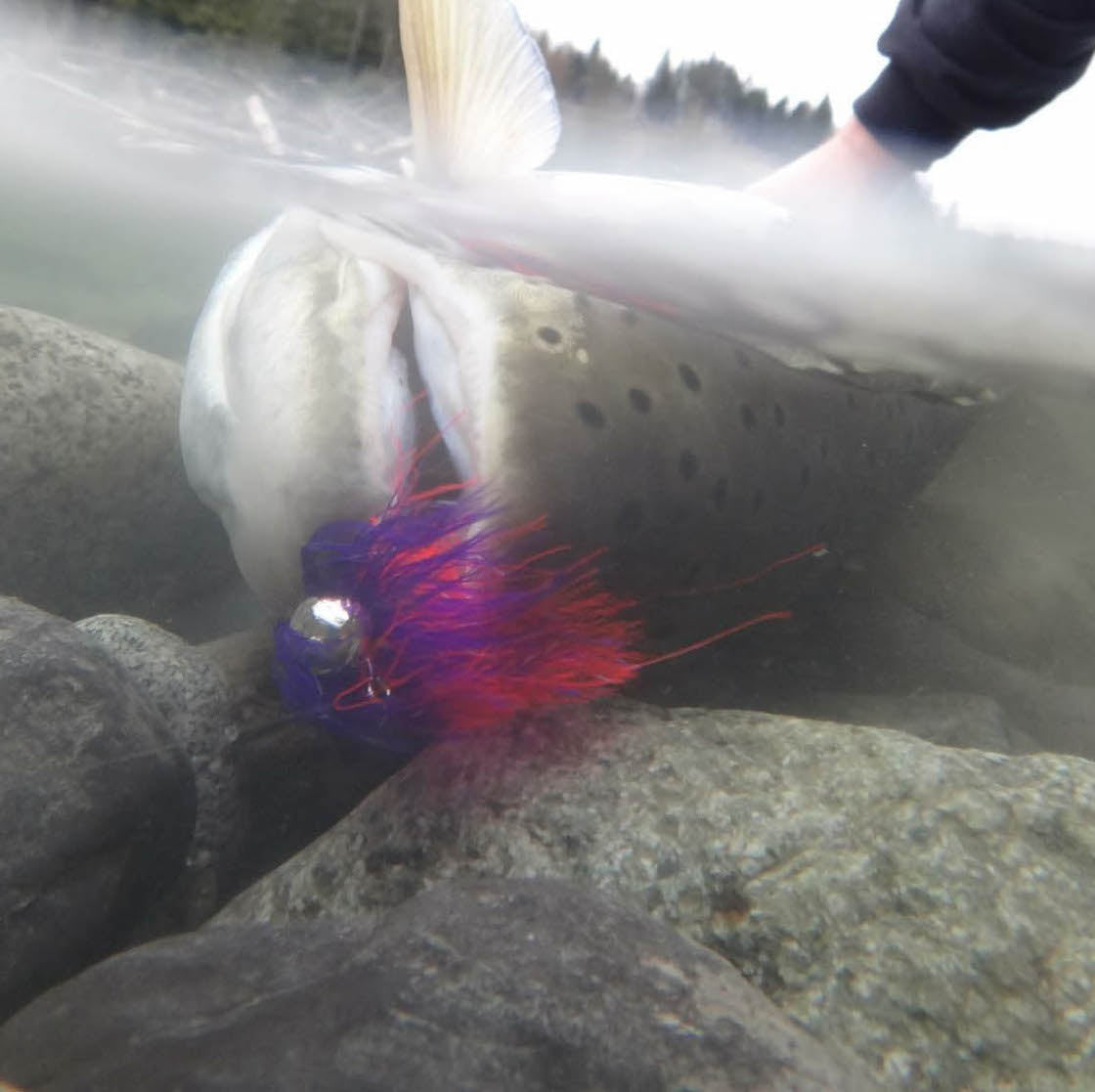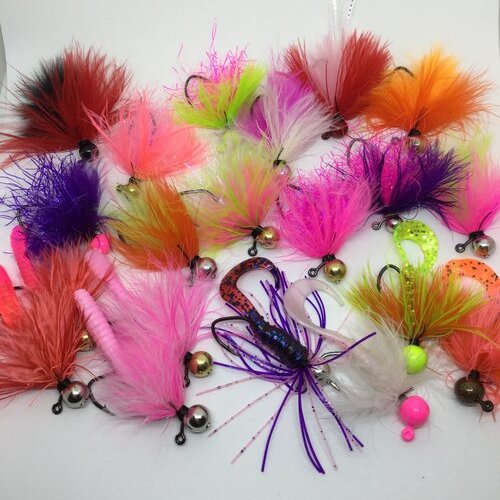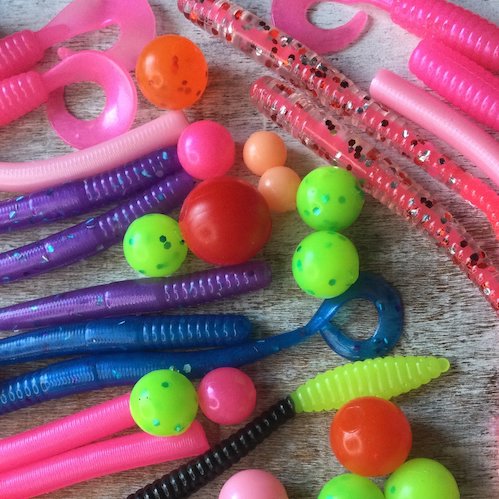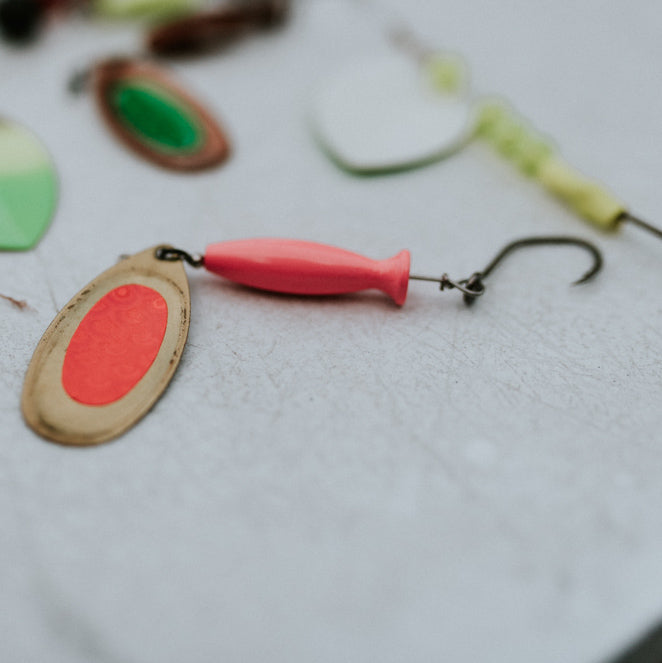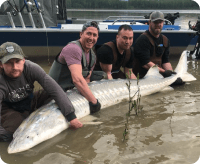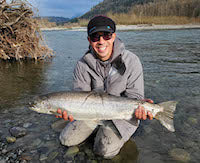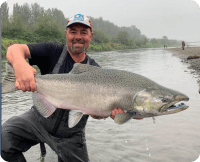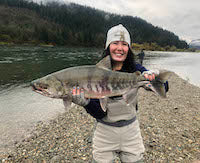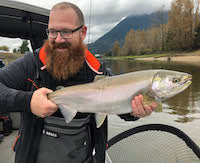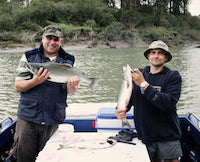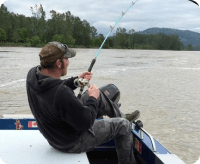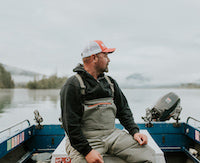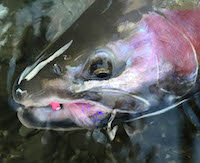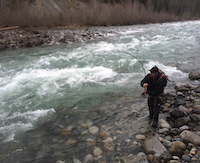The Fraser Valley of British Columbia is world renowned for its lush forests and beautiful scenery, but for the fly fisherman there is so much more.
The Fraser Valley in January is normally cold and wet; temperatures are typically between 2-10 degrees with the odd colder spell that will freeze local ponds.
During this early part of the year the main focus for the fly fisher is the amazing Winter Steelhead Trout.
The Steelhead is nothing more than a Rainbow Trout which has migrated to the ocean to grow fat and silver. Three to four years of ocean feeding turns these once spotted and colorful creatures into silver sided missiles with huge energy reserves, and amazing power.
For the fly fisher these Winter Steelhead present a great challenge and formidable quarry. Cold water and large flows that often run colored make tough conditions for the angler. The most common technique fly fishers employ is that of the swung fly on a sink tip line. Typically fly fishers will use a dry line with a loop on sink tip, with type 6 and 8 being the favorites. Some anglers build their own tips using heavy T-14 line and these tips drop very quickly in the water column.
Long days and thousands of casts is the recipe for success with Winter Steelhead.
The flies used for this fishery are much varied and normally quite large. Anglers typically tie very colorful creations using all manner of materials.
Some local favorites are “popsicles” made from Marabou, “intruder” style flies both beautiful and buggy and traditional “Spey” flies also seeing much action.
While fly patterns can make a difference, Steelhead will take most bright and lively patterns put in front of them, with presentation being the key to success.
In the last few years two handed rods and huge flies have become the favored method of presenting to Winter Steelhead. This technique allows for casting huge, colorful creations and keeps line stripping to a bare minimum.
Winter Steelheading really gets going in February and stays strong until the end of April. March and April present the best opportunities for the Fly Fisher with warming air and water temperatures making both fish and angler more active.
As Winter releases her grip on the Fraser Valley, fly fishing options become many and varied.
With the warming of local rivers, Salmon fry are hatching in great numbers and many predator fish begin to target these tasty little Salmon.
Cutthroat Trout, both coastal sea runs and Fraser resident fish are determined in their single minded pursuit of Salmon fry. Small realistic fry patterns are popular for Cutthroat, with the “Rolled Muddler” a local favorite. Anglers seek out the nomadic Cutthroat in the Fraser River, her many tributaries, sloughs and backwaters.
Another predator fish that is actively feeding on fry during the spring is the Dolly Varden or Bull Trout, part of the Char family.
While these are actually two separate species, they are extremely similar and behave in much the same way. For all intents we consider them a single species and target them with the same fly fishing techniques.
The favored method for catching these aggressive fish is to cast very large attractor style flies that loosely resemble Salmon fry. Our flies for catching Bull trout can be up to six inches long and can attract fish from long distances.
The most popular technique is to cast the large weighted flies with a floating line and sink tip. Casts are made 45 degrees downstream and a quick mend is made to help the fly sink.
As the fly swings around, large strips are made to trigger the Bull Trout’s predatory instincts and strikes can be violent and spectacular.
Special attention must be given to spots that provide ambush for the Bull trout, casts made near logs and overgrown brush are often met with violent takes from a hiding fish- great sport indeed!
This fishery carries on until late May or until rivers are blown out from Spring Freshet.
While summer provides all manner of possibilities to the fly fisher in the Fraser Valley, most options are for small Trout in lakes and rivers, as well as some opportunities for Summer Steelhead in very remote locations.
Just a short trip from the Fraser Valley is the Thompson River ,and the Fly Fishing on this stream is world class.
As summer turns to fall some of the greatest fly fishing opportunities on the planet present themselves in the Fraser Valley.
In Late August on odd numbered years (2005, 2007….) the return of Millions of Pink Salmon is met with joy by
flyfFishers from around the globe.
This event must be witnessed to be appreciated; the Fraser River literally boils with these silvery little fish.
The Pink Salmon weighs from 4-10 pounds and is an eager biter. Fly anglers have had success with all manner of flies and it seems everyone has their favorite.
Pink flies with lots of sparkle and flash are my favorites and range from small and sparse to large and gaudy, depending on where you are targeting Pink Salmon.
I’ve witnessed anglers become completely arm weary from catching hundreds of Pink Salmon in a day.
The prediction for 2007 is for the return of 25 million pinks; my arms ache from the thought of all the great days ahead, fly fishing for this wonderful little Salmon.
Also of interest to the Fraser Valley fly fisher is the many other returning Salmon.
Sockeye Salmon also return in the millions to the Fraser River and early fall witnesses a great run of these hard fighting fish to the Fraser Valley’s “Harrison River”. Harrison Sockeye can be great biters and spectacular fighters, with aerial displays a trademark of these fish.
The flies we use for the Sockeye Salmon are very small and sparse, with pink, red and chartreuse being my personal favorites.
I like to target Sockeye in brackish water and use cast and strip techniques to entice them to bite.
As the Sockeye tend to school up, casting near a shoal of them and trying to draw some away from the pack is my favored method.
Another exciting sport fish for the fly fisherman is the Chum salmon. While Chum Salmon often return to the area with colorful sides and large teeth, their sporting qualities are certainly still there and I can think of no fish that puts up a more determined fight than these brutes.
Chum Salmon are typically targeted with light sink tips (type 6, 15 ft) and colorful flies.
The use of Marabou, Ostrich, schlappen feathers and other materials with much lifelike movement works well for these Salmon.
The rods of choice, are beefy 9 weight outfits with a big emphasis to having a longer butt section. Two handed rods are great for Chum fishing, with good back bone and greater line control. The key to enjoyable Chum fishing is to avoid foul hook ups. Casting downstream and very slowly swinging your fly in front and above their holding position will result in many good hookups.
Fly fishing for Chum Salmon is a full contact sport; broken gear, lost flies and the rare nasty gash typically accompany the sore arms at the days end.
Another Salmon that anglers target in the fall months is the mighty Chinook, often referred to as the King Salmon.
The Chinook is the largest of all Salmon and the Fraser River boasts one of the largest runs of wild Chinook Salmon on the planet.
From mid March until November, Chinook can be found within the Fraser River Basin.
While a few anglers access remote locations in early spring for a chance at Chinooks on the fly, typically September and October is when access to these fish is best.
Swinging large gaudy flies in the Harrison and Fraser Rivers in the fall can result in a hook up with a mighty Chinook Salmon. Hold on tight when a Chinook grabs your fly as they quickly head down river, every bit determined to go back to the ocean.
The same flies that will take Chum Salmon will catch the Chinook. Big, bright and plenty of movement is a good recipe. Dark colored “intruder” style flies have been used with good success in recent years.
Long hours are spent casting in hopes of an encounter with an awesome Fraser River Chinook, but catching one is a memory to last a lifetime.
The last of the Salmon to arrive in The Fraser Valley is the Coho Salmon, known to many anglers as the Silver Salmon.
Coho once were very abundant throughout the fall, but recently have been much easier to find late in the season.
Coho are great sport with a fly rod. Anglers prefer the use of single handed rods in 7 and 8 weights and normally use slow sinking lines or a dry line with a slow sinking, clear tip.
Flies are mostly lightly dressed ones, with a lot of flash and dark hues. Local anglers all have specialized patterns that they favor and most work well.
The key to a great day of Coho Fishing is finding a group of “players”. These Salmon will mostly be found in slow water with access to deep holes or cover. The Coho tend to stay in groups and once you are into a bite, it can usually last until the fish are spooked and move.
The technique is to cast near the group of Coho and use stripping techniques to get them to chase down your fly. Coho love to chase their food and drawing on this instinct is the best method of consistently hooking up.
Those days when the conditions are perfect, with Coho plentiful and biting well, come often enough to make this fishery quite addictive.
Fly fishing for Coho can last well into December and barely gives the angler time to clean up his gear in preparation for the arrival of Winter Steelhead once again.
The biggest dilemma for the Fly Fisher in the Fraser Valley is finding time to tie flies, as opportunities exist 365 days a year in this Fly Fishing Paradise.
Rod Toth
Head Guide
The Fraser Valley in January is normally cold and wet; temperatures are typically between 2-10 degrees with the odd colder spell that will freeze local ponds.
During this early part of the year the main focus for the fly fisher is the amazing Winter Steelhead Trout.
The Steelhead is nothing more than a Rainbow Trout which has migrated to the ocean to grow fat and silver. Three to four years of ocean feeding turns these once spotted and colorful creatures into silver sided missiles with huge energy reserves, and amazing power.
For the fly fisher these Winter Steelhead present a great challenge and formidable quarry. Cold water and large flows that often run colored make tough conditions for the angler. The most common technique fly fishers employ is that of the swung fly on a sink tip line. Typically fly fishers will use a dry line with a loop on sink tip, with type 6 and 8 being the favorites. Some anglers build their own tips using heavy T-14 line and these tips drop very quickly in the water column.
Long days and thousands of casts is the recipe for success with Winter Steelhead.
The flies used for this fishery are much varied and normally quite large. Anglers typically tie very colorful creations using all manner of materials.
Some local favorites are “popsicles” made from Marabou, “intruder” style flies both beautiful and buggy and traditional “Spey” flies also seeing much action.
While fly patterns can make a difference, Steelhead will take most bright and lively patterns put in front of them, with presentation being the key to success.
In the last few years two handed rods and huge flies have become the favored method of presenting to Winter Steelhead. This technique allows for casting huge, colorful creations and keeps line stripping to a bare minimum.
Winter Steelheading really gets going in February and stays strong until the end of April. March and April present the best opportunities for the Fly Fisher with warming air and water temperatures making both fish and angler more active.
As Winter releases her grip on the Fraser Valley, fly fishing options become many and varied.
With the warming of local rivers, Salmon fry are hatching in great numbers and many predator fish begin to target these tasty little Salmon.
Cutthroat Trout, both coastal sea runs and Fraser resident fish are determined in their single minded pursuit of Salmon fry. Small realistic fry patterns are popular for Cutthroat, with the “Rolled Muddler” a local favorite. Anglers seek out the nomadic Cutthroat in the Fraser River, her many tributaries, sloughs and backwaters.
Another predator fish that is actively feeding on fry during the spring is the Dolly Varden or Bull Trout, part of the Char family.
While these are actually two separate species, they are extremely similar and behave in much the same way. For all intents we consider them a single species and target them with the same fly fishing techniques.
The favored method for catching these aggressive fish is to cast very large attractor style flies that loosely resemble Salmon fry. Our flies for catching Bull trout can be up to six inches long and can attract fish from long distances.
The most popular technique is to cast the large weighted flies with a floating line and sink tip. Casts are made 45 degrees downstream and a quick mend is made to help the fly sink.
As the fly swings around, large strips are made to trigger the Bull Trout’s predatory instincts and strikes can be violent and spectacular.
Special attention must be given to spots that provide ambush for the Bull trout, casts made near logs and overgrown brush are often met with violent takes from a hiding fish- great sport indeed!
This fishery carries on until late May or until rivers are blown out from Spring Freshet.
While summer provides all manner of possibilities to the fly fisher in the Fraser Valley, most options are for small Trout in lakes and rivers, as well as some opportunities for Summer Steelhead in very remote locations.
Just a short trip from the Fraser Valley is the Thompson River ,and the Fly Fishing on this stream is world class.
As summer turns to fall some of the greatest fly fishing opportunities on the planet present themselves in the Fraser Valley.
In Late August on odd numbered years (2005, 2007….) the return of Millions of Pink Salmon is met with joy by
flyfFishers from around the globe.
This event must be witnessed to be appreciated; the Fraser River literally boils with these silvery little fish.
The Pink Salmon weighs from 4-10 pounds and is an eager biter. Fly anglers have had success with all manner of flies and it seems everyone has their favorite.
Pink flies with lots of sparkle and flash are my favorites and range from small and sparse to large and gaudy, depending on where you are targeting Pink Salmon.
I’ve witnessed anglers become completely arm weary from catching hundreds of Pink Salmon in a day.
The prediction for 2007 is for the return of 25 million pinks; my arms ache from the thought of all the great days ahead, fly fishing for this wonderful little Salmon.
Also of interest to the Fraser Valley fly fisher is the many other returning Salmon.
Sockeye Salmon also return in the millions to the Fraser River and early fall witnesses a great run of these hard fighting fish to the Fraser Valley’s “Harrison River”. Harrison Sockeye can be great biters and spectacular fighters, with aerial displays a trademark of these fish.
The flies we use for the Sockeye Salmon are very small and sparse, with pink, red and chartreuse being my personal favorites.
I like to target Sockeye in brackish water and use cast and strip techniques to entice them to bite.
As the Sockeye tend to school up, casting near a shoal of them and trying to draw some away from the pack is my favored method.
Another exciting sport fish for the fly fisherman is the Chum salmon. While Chum Salmon often return to the area with colorful sides and large teeth, their sporting qualities are certainly still there and I can think of no fish that puts up a more determined fight than these brutes.
Chum Salmon are typically targeted with light sink tips (type 6, 15 ft) and colorful flies.
The use of Marabou, Ostrich, schlappen feathers and other materials with much lifelike movement works well for these Salmon.
The rods of choice, are beefy 9 weight outfits with a big emphasis to having a longer butt section. Two handed rods are great for Chum fishing, with good back bone and greater line control. The key to enjoyable Chum fishing is to avoid foul hook ups. Casting downstream and very slowly swinging your fly in front and above their holding position will result in many good hookups.
Fly fishing for Chum Salmon is a full contact sport; broken gear, lost flies and the rare nasty gash typically accompany the sore arms at the days end.
Another Salmon that anglers target in the fall months is the mighty Chinook, often referred to as the King Salmon.
The Chinook is the largest of all Salmon and the Fraser River boasts one of the largest runs of wild Chinook Salmon on the planet.
From mid March until November, Chinook can be found within the Fraser River Basin.
While a few anglers access remote locations in early spring for a chance at Chinooks on the fly, typically September and October is when access to these fish is best.
Swinging large gaudy flies in the Harrison and Fraser Rivers in the fall can result in a hook up with a mighty Chinook Salmon. Hold on tight when a Chinook grabs your fly as they quickly head down river, every bit determined to go back to the ocean.
The same flies that will take Chum Salmon will catch the Chinook. Big, bright and plenty of movement is a good recipe. Dark colored “intruder” style flies have been used with good success in recent years.
Long hours are spent casting in hopes of an encounter with an awesome Fraser River Chinook, but catching one is a memory to last a lifetime.
The last of the Salmon to arrive in The Fraser Valley is the Coho Salmon, known to many anglers as the Silver Salmon.
Coho once were very abundant throughout the fall, but recently have been much easier to find late in the season.
Coho are great sport with a fly rod. Anglers prefer the use of single handed rods in 7 and 8 weights and normally use slow sinking lines or a dry line with a slow sinking, clear tip.
Flies are mostly lightly dressed ones, with a lot of flash and dark hues. Local anglers all have specialized patterns that they favor and most work well.
The key to a great day of Coho Fishing is finding a group of “players”. These Salmon will mostly be found in slow water with access to deep holes or cover. The Coho tend to stay in groups and once you are into a bite, it can usually last until the fish are spooked and move.
The technique is to cast near the group of Coho and use stripping techniques to get them to chase down your fly. Coho love to chase their food and drawing on this instinct is the best method of consistently hooking up.
Those days when the conditions are perfect, with Coho plentiful and biting well, come often enough to make this fishery quite addictive.
Fly fishing for Coho can last well into December and barely gives the angler time to clean up his gear in preparation for the arrival of Winter Steelhead once again.
The biggest dilemma for the Fly Fisher in the Fraser Valley is finding time to tie flies, as opportunities exist 365 days a year in this Fly Fishing Paradise.
Rod Toth
Head Guide



